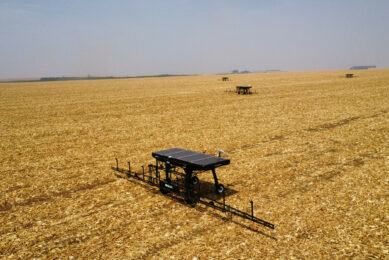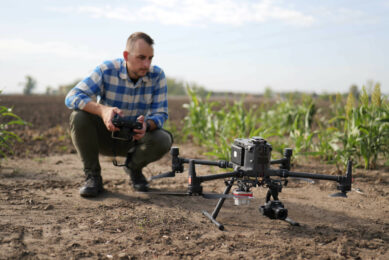German vineyards prevent soil compaction by spraying with a drone

Wine estates Heitlinger and Burg Ravensburg in Germany are currently spraying with a drone to protect their vines and grapes. This allows them to spray at any time and prevent soil compaction.
“If we would have had the drone last year, our results would have been much better”, says Patrick Jacklin, third generation of the owner-family at Heitlinger & Burg Ravensburg.
Mr Jacklin is one of three drone pilots in the company. Before using the drone, the biodynamic wineries of Heitlinger & Burg Ravensburg had to wait for dry and passable soil conditions to drive tractors and machinery into the vineyards, he explains.
“In 2021, we had long raining periods all the time during the spraying season. If it rains, you have to wait and apply your crop protection before it rains again. And if it rains again before it dries, you can’t do it. So, with all the rain last year, the vines were unprotected when they needed it most.”
Text continues below image

Soil compaction
Driving down wet slopes is dangerous, he emphasises, and it causes compaction of the soil. “We try to protect our soil as much as we can. Driving over wet soil, makes it as hard as concrete. Basically, you lose the drainage and the life in the soil. Last year, because we were not able drive on our slopes and spray our grapes, we had problems with fungus, and harvested only 40% of what we consider normal.”
After this bad experience in 2021, Heitlinger & Burg Ravensburg decided to join drone-testing in Germany, and start spraying with a drone. The technology is being tested in cooperation with the Landesversuchsanstalt für Wein- und Obstbau (Germany’s state research institute for viticulture and fruit growing). The winery is using the drone, so that the practicability of agricultural drones in a large organic winery can be tested.
A good year to trial spraying with a drone
Mr Jacklin: “We knew, that if we would have had the drone last year, our results would have been much better in 2021. So, we decided to start using a drone in May this year. This season, we didn’t need the drone necessarily, but it was a good year to trial it.”
Text continues below video
The organic winery, one of the biggest in Germany, has 120 hectares of vineyards. The drone is used in an area of 10 hectares. The company only uses the drone, where there are steep slopes (more that 30%). So far, the use is limited, because Heitlinger & Burg Ravensburg has more areas, that are steeper than 30%. “But we wanted to use an area that we can actually reliably cover with one drone, so we limited ourselves to 10ha for now.”
Several permits needed for spraying with a drone
The company needs several permits, to be able to use the drone in Germany, Mr Jacklin says. “In some ways, the rules don’t differentiate between helicopters and drones. You need the same certificates to fly over certain areas. I believe this may change, when the use of drones becomes more common, but at the moment you have to jump through quite a few hoops to get going.”
Text continues below image

The company is using a DJI Agras T30, provided by the state research institute for viticulture and fruit growing . Including four batteries, it costs around €25,000. Two separate licences cost €35 and €320. For reasons of insurance, there must always be two pilots present. The company is also required to get extra insurance for the drone.
The batteries last for approximately 15 to 20 minutes. With the 30-litre tank, the batteries usually last for two full tanks. Flight planning and setting of the flight and spray parameters are done on a tablet of the remote control. The application rate, the spray mode and the flight speed can also be set. The data is transmitted to the drone by radio. Flight plans are stored in the software and can be retrieved at any time.
No pesticides
The biodynamic wineries do not use pesticides, and are currently using the drone to protect their vines and grapes, spraying products such as chamomile, nettle and field horsetail teas. The drone has recently also been used for after harvest treatments. The drone has limitations in Germany, since spraying drones are only allowed in areas with slopes, steeper than 30%. “It would be interesting to also use it in flat areas”, Mr Jacklin says.
Text continues below image

“The drone is not as effective as a tractor. But it is a good addition. We will still be using our tractors. But we only started in May this year, and we didn’t have the fungus pressure we had last year, so it is hard to compare. We are happy with it, but we will have to wait for a really wet year to see how it compares.”
Because the drone produces a pretty fine mist, we did get a full film on the leaves, and a nice coverage of the vines
The application of treatments worked better than expected. “We were sceptical at first. We did not know how close we could get with the drone. If you use a tractor, you are inside the vineyard and spray onto the sides of the grapevine. It is important to also spray under the leave. But with a drone, you are approaching the grapevines from above. But because the drone produces a pretty fine mist, we did get a full film on the leaves, and a nice coverage of the vines.“
Pilot required in vineyards
Even though drones can fly autonomous, in vineyards they also require a pilot to assist with the navigation, Mr Jacklin explains. “In a vineyard, you always have wires, and there is a lot of metal, so the radar can often be a bit confused. It could think that a metal post is the ground, and stop flying. Then you have to recalibrate it. You have to be there, with the remote control in your hands. But for most of the time, it does all the work by itself.”
Text continues below image

The interest of other German vineyards in the technology is growing. “We had an event here, with several winemakers. It was really interesting. Some visitors had to drive for three hours to just listen to our experience. Of course they can read reports on drones. But it is usually more interesting for a winemaker to hear a colleague talk about his experience. Many of them reached out to us saying that so far haven’t really thought of it actually being practical in their vineyards. After 2021 many winemakers are looking for ways to improve their crop protection, as they realised that the traditional methods have their limits. Some other winemakers asked us: how do we get started?”
Mr Jacklin says that Heitlinger & Burg Ravensburg will definitely keep using the drone. “We are convinced that we are only at the beginning. We think that the technology will improve. If you look at drones – and at cars or phones – batteries are still a limiting factor. In the future, we will be able to fly our drones for longer.”
Text continues below image

Join 17,000+ subscribers
Subscribe to our newsletter to stay updated about all the need-to-know content in the agricultural sector, two times a week.



